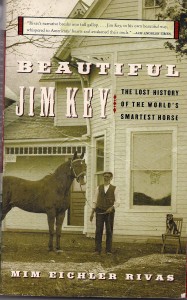
WHAT WAS IT ABOUT BEAUTIFUL JIM KEY’S STORY THAT ATTRACTED YOU TO WRITE THE BOOK?
My cousin sent me an email with the heading “Horse from Tennessee” when I was working on another book and even though people are always sending me emails about amazing stories they’ve uncovered, the fact that I’m from Tennessee and love horses made me read the synopsis of the story. Though skeptical about some of the claims in the account that I read, once I started my research and found so much information to back up the claims, I had to get to the bottom of how this important, true story had become lost in history. As I often say—never look a gift horse in the mouth!
CAN YOU SHARE WITH OUR READERS A FEW OF JIM KEY’S SPECIAL ABILITIES?
Between 1897 and 1906, Beautiful Jim Key performed live in front of as many as ten million Americans (performing in several shows a day as the top selling box office star in the nation), demonstrating
his uncanny special abilities as described in a 1898 flyer: “He reads, writes, spells, counts, figures, changes money, uses the cash register, rings up fares, plays the organ (harmonica), tells time, picks
out colors and flags, etc…, etc….” One of his most impressive feats was retrieving a silver dollar from the bottom of a glass barrel of water. He later was taught to identify Bible passages by hearing them
citing and then selected the name of the chapter and verse as printed on display cards.
YOUR BOOK TELLS THE TRUE TALE ABOUT BEAUTIFUL JIM KEY. THE BOOK TELLS A RICH HISTORY ABOUT THE PERIOD OF TIME IN WHICH HE LIVED. WHAT KIND OF RESEARCH WAS INVOLVED IN THE BOOK?
David Hoffman, the documentary filmmaker who first helped to uncover the story and who is a friend of my cousin, had first presented me with a treasure trove of research, including copies of Jim’s promotional brochure and original newspaper clippings reviewing Jim’s performances. From there, I came at the research through multiple avenues, starting with a closer look at Dr. William Key, the former slave
and self-taught veterinarian turned successful entrepreneur and inspiration for the humane
movement, who was born in 1833 and who left a strong mark in Shelbyville, Tennessee— where both he and Jim are buried. Part of the research was done by physically retracing Dr. Key’s footsteps, starting in Shelbyville and interviewing locals about stories they had heard from family members. In addition to following Doc Key’s genealogy I went on to research not only the history of slavery in Tennessee
but the influence of African-Americans in the horse world at large, in veterinary medicine, and in the history of American show business. In addition to librarians and special archives researchers who assisted me, I had the benefit of unpublished documents that helped me follow Dr. Key’s journey through the Civil War, during which he was present at pivotal battles. For Beautiful Jim Key’s lineage, I used
numerous sources to get to the bottom of how the Arabian-Hambletonian had been bred. The history of Albert R. Rogers, the promoter who helped bring Doc Key and Jim into the public eye, also opened up another avenue for fascinating research into the influence of World’s Fairs and major expositions. Another
significant area of research was the history of the humane movement and how Jim Key helped to galvanize it at a time when it was not mainstream.
TELL US ABOUT JIM KEY’S OWNER AND HIS TRAINING METHODS?
Dr. William Key—Doc or Bill Key as he was known—had grown up as a valued asset for his gifts with communicating with animals, working with horses and mules, and helping to tame the wildest, most poorly behaved horses. Before it was in fashion, Bill Key opposed ‘breaking’ horses with forces but rather emphasized that with kindness and patience, yet also strict setting of rules, any horse of slightly above
average intelligence could be taught to do the things that Jim learned. Initially, Jim was curious and wanted to know what objects were and then he was taught to be part of Dr. Key’s patent medicine show—with repetition and demonstration and rewards the main elements. Jim learned so quickly that Doc decided to
try to teach him the letter A, using sugar sprinkled on the letter and teaching Jim to fetch the letter that was going to give him the sugar. He took three years of practice to get him to learn his A, B, C, but only four years more to learn the entire alphabet. They then began working on spelling phonetically, with Jim being taught much as children at the time were taught in the classroom. Similarly, Jim learned basic math with numbers up to 30—. Dr. Key taught him to write his name in cursive on a blackboard again by putting the sugar in the pattern that he wanted him to lick. Then he coated the blackboard in chalkdust and gave Jim a sponge to put in his mouth and erase his name in the same pattern.
JIM KEY WAS SEEN BY 10 MILLION AMERICANS. WHY DO YOU THINK HIS STORY HAD BEEN RELATIVELY UNKNOWN UNTIL YOU DECIDED TO WRITE ABOUT HIM?
I have a few theories. First of all, I think that because Doc Key had no children or descendents to carry on his story and make sure that the world didn’t forget, it eventually became lost in time. Also, I
think the world changed so dramatically with the arrival of the automobile, followed by industrialization and then the changes brought about by World War I, that the story of a horse who was so human all that he lacked was speech became a kind of urban legend. I’m sure that the creators of “Mr. Ed” must have heard someone in their families talking about Jim Key. But these stories probably sounded far-fetched as time went on. Unfortunately, I think that racism had something to do with the story being underplayed or taken seriously.
ALBERT ROGERS, AS JIM KEY’S PROMOTER, USED THE TAG LINE “HE WAS TAUGHT BY KINDNESS AND PATIENCE”.
HOW IMPORTANT WAS IT THAT THE HUMANE SOCIETY GOT BEHIND JIM AND HIS PERFORMANCES?
Albert Rogers knew from the moment that Jim made his debut onto the national scene in the Tennessee Centennial of 1897 (when President William McKinley called Jim the greatest object lesson of the power
of kindness ever told) that the Keys could help bring attention to the work of the many humane societies that were then a loose alliance of groups who didn’t have a clear agenda. Once Beautiful Jim Key teamed up
with the Massachusetts SPCA with George Angell, the same visionary who brought Black Beauty to America, the phrase “Be Kind to Animals” came into being. That was important to both Jim’s fame (and the fact that 2 million children signed the Jim Key pledge to be kind to animals) but also to the elevation of the
movement.
HAS HOLLYWOOD COME KNOCKING ON YOUR DOOR YET TO MAKE A MOVIE ABOUT JIM KEY?
A movie is in fact in the works with awardwinning screenwriter Robert Rodat (“Saving Private Ryan”) writing and directing. Hopefully there will be big news to announce soon.
IS THERE A WEBSITE DEDICATED TO JIM KEY AND ANY UPDATES WE CAN FOLLOW?
www.beautifuljimkey.com is the dedicated website for the book itself. Readers can always drop me a line a mim@bringbackkindness.com to be put on the mailing list for latest updates.



